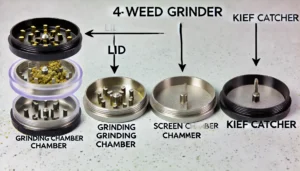Hermaphrodite Weed Seeds: Everything You Need to Know
Hermaphrodite cannabis is a phenomenon that occurs when a plant develops both male and female reproductive organs. While hermaphroditism can be a survival mechanism in nature, it poses significant challenges for growers who want to maximize their harvest.
In this guide, we’ll explain what hermaphroditism is, what causes it, how to identify it, and what to do if you find a hermie plant in your grow room. Learning how to spot male, female, and hermaphrodite cannabis plants early can help you avoid unwanted pollination and protect your harvest.
Help! I’ve Grown Hermaphrodite Cannabis; What Do I Do Now?
Did you know that cannabis plants can have multiple genders? While most growers focus on male and female plants, hermaphrodite cannabis is a unique variation that contains both reproductive structures.
While hermaphrodite plants are not inherently useless, they can cause unnecessary stress by producing seeds instead of high-quality buds. If not managed properly, a single hermie can pollinate an entire crop, reducing potency and yield.
Here’s what you need to know about cannabis plant genders and how to handle hermaphrodite marijuana effectively.
Cannabis Plant Genders: Male, Female, and Hermaphrodite
Male Cannabis Plants
- Produce pollen sacs instead of flowers.
- Essential for breeding new strains but not for bud production.
- Have thicker stalks and fewer leaves than female plants.
- Grow faster than females and do not develop pistils.
Female Cannabis Plants
- Grow pistils (small, hair-like structures) that collect pollen.
- Produce THC-rich flowers ideal for consumption.
- Can grow into dense, resinous buds when unpollinated.
- Feminized seeds eliminate the risk of male plants.
Hermaphrodite Cannabis Plants
- Contain both pollen sacs and female flowers.
- Self-pollinate, leading to seeded buds instead of pure flowers.
- Can occur naturally or due to environmental stress.
What Causes Cannabis Hermaphroditism?
Several factors can cause a cannabis plant to become hermaphroditic. Here are the most common reasons:
1. Environmental Stress
- Light stress (irregular light cycles, leaks, or broken timers)
- Temperature extremes (too hot or too cold)
- High humidity or poor air circulation
- Pest infestations or plant diseases
2. Incorrect Training Methods
- Over-pruning or aggressive topping
- High-Stress Training (HST)
- Transplanting during flowering
3. Poor Nutrient Balance & Growing Medium
- Overfeeding or underfeeding nutrients
- Unstable pH levels
- Inferior soil or hydroponic conditions
4. Prolonged Flowering Stage
- If a plant is left in the flowering stage too long, it may develop male traits as a last resort to reproduce.
How to Identify a Hermaphrodite Cannabis Plant
Signs of a Hermie Plant
- Presence of both male and female reproductive organs.
- Pollen sacs forming alongside pistils.
- Banana-like growths (“nanners”) in buds.
What Do Nanners Look Like?
- Unlike full pollen sacs, nanners are small, yellow, and shaped like bananas.
- They contain pollen and can self-pollinate the plant.
What to Do If You Find a Hermie Plant?
- Remove the Plant from the Grow Room
- Prevent accidental pollination of female plants.
- Trim Off Male Growth
- Use sterilized tweezers or scissors to carefully remove pollen sacs.
- Monitor for Further Male Growth
- Continue checking the plant to ensure no new male parts appear.
- Decide Whether to Keep or Remove the Plant
- If the hermie is heavily pollinating, it’s best to remove it entirely.
Uses for Hermaphrodite Cannabis Plants
While hermaphrodite plants are generally avoided, they can still be useful:
- Pollination & Feminization – Use pollen for breeding new strains.
- Cannabis Concentrates – Extract THC from pollen sacs for making hash, rosin, and tinctures.
- Learning & Experimentation – New growers can study hermaphroditism to improve future cultivation techniques.
How to Avoid Hermaphrodite Weed Plants
To prevent cannabis plants from becoming hermaphrodites, follow these best practices:
✅ Buy Seeds from Reputable Seed Banks – Quality genetics reduce the risk. ✅ Control Light Cycles – Maintain a consistent 12/12 schedule in flowering. ✅ Optimize Environmental Conditions – Stable temperature, humidity, and airflow. ✅ Use Low-Stress Training (LST) – Avoid aggressive pruning or high-stress techniques. ✅ Harvest at the Right Time – Don’t leave plants flowering for too long.
FAQs on Hermaphrodite Cannabis
1. Can a hermaphrodite pollinate a female plant?
Yes. If a hermie releases pollen, it will fertilize female plants, leading to seeded buds.
2. Can you smoke hermaphrodite buds?
Yes, but they are typically less potent and contain more seeds. Many growers prefer extracting concentrates instead.
3. How common is hermaphroditism in cannabis?
It depends on genetics and growing conditions. Poor environmental control increases the chances of hermaphrodites.
Final Thoughts
Hermaphrodite cannabis plants can be frustrating for growers, but with proper care and high-quality genetics, they can be minimized or avoided entirely.
By keeping a close eye on your plants, providing a stable growing environment, and using reliable feminized seeds, you can reduce the chances of hermaphroditism and ensure a successful, high-yielding harvest.
If you’re serious about growing, invest in feminized seeds and create an optimal environment to maximize your THC-rich, seed-free buds. Happy growing!













